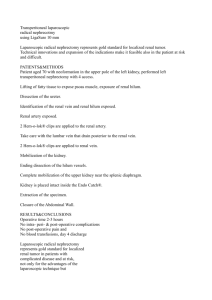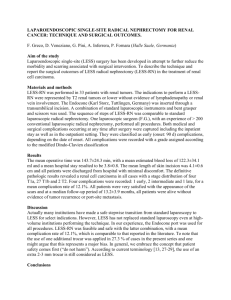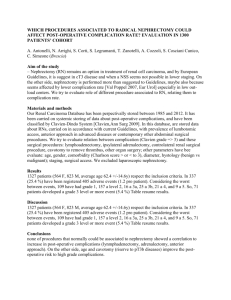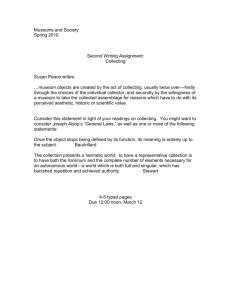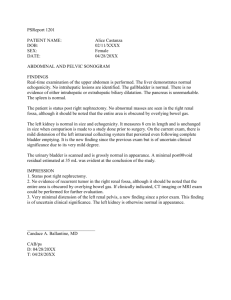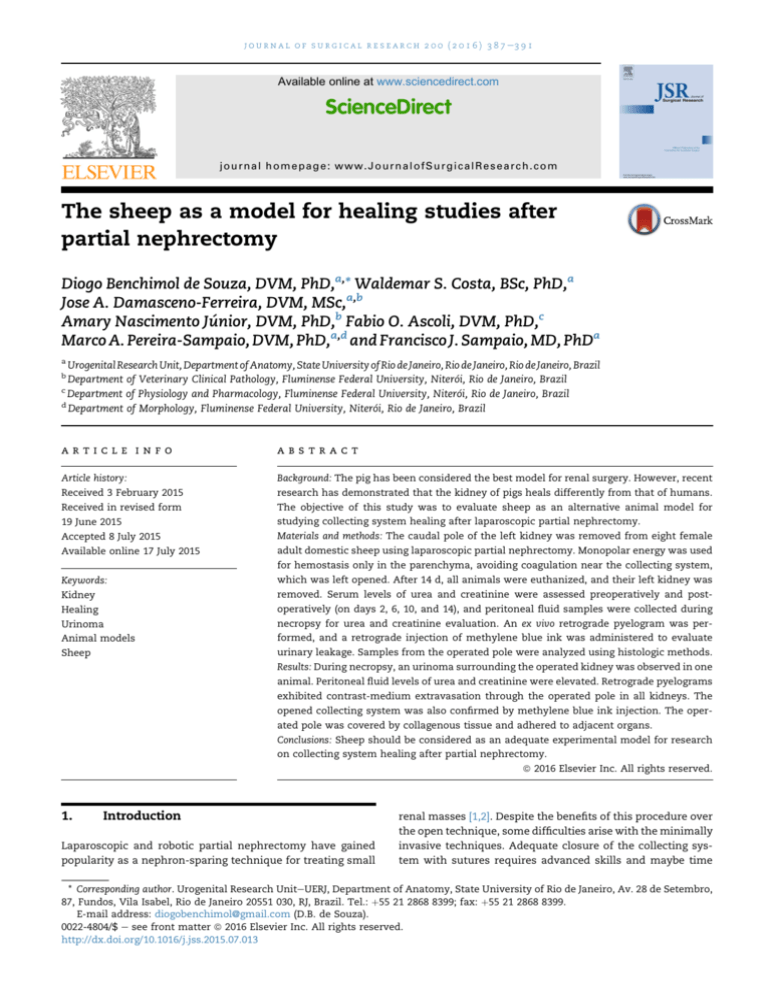
j o u r n a l o f s u r g i c a l r e s e a r c h 2 0 0 ( 2 0 1 6 ) 3 8 7 e3 9 1
Available online at www.sciencedirect.com
ScienceDirect
journal homepage: www.JournalofSurgicalResearch.com
The sheep as a model for healing studies after
partial nephrectomy
Diogo Benchimol de Souza, DVM, PhD,a,* Waldemar S. Costa, BSc, PhD,a
Jose A. Damasceno-Ferreira, DVM, MSc,a,b
Amary Nascimento Júnior, DVM, PhD,b Fabio O. Ascoli, DVM, PhD,c
Marco A. Pereira-Sampaio, DVM, PhD,a,d and Francisco J. Sampaio, MD, PhDa
a
Urogenital Research Unit, Department of Anatomy, State University of Rio de Janeiro, Rio de Janeiro, Rio de Janeiro, Brazil
Department of Veterinary Clinical Pathology, Fluminense Federal University, Niterói, Rio de Janeiro, Brazil
c
Department of Physiology and Pharmacology, Fluminense Federal University, Niterói, Rio de Janeiro, Brazil
d
Department of Morphology, Fluminense Federal University, Niterói, Rio de Janeiro, Brazil
b
article info
abstract
Article history:
Background: The pig has been considered the best model for renal surgery. However, recent
Received 3 February 2015
research has demonstrated that the kidney of pigs heals differently from that of humans.
Received in revised form
The objective of this study was to evaluate sheep as an alternative animal model for
19 June 2015
studying collecting system healing after laparoscopic partial nephrectomy.
Accepted 8 July 2015
Materials and methods: The caudal pole of the left kidney was removed from eight female
Available online 17 July 2015
adult domestic sheep using laparoscopic partial nephrectomy. Monopolar energy was used
for hemostasis only in the parenchyma, avoiding coagulation near the collecting system,
Keywords:
which was left opened. After 14 d, all animals were euthanized, and their left kidney was
Kidney
removed. Serum levels of urea and creatinine were assessed preoperatively and post-
Healing
operatively (on days 2, 6, 10, and 14), and peritoneal fluid samples were collected during
Urinoma
necropsy for urea and creatinine evaluation. An ex vivo retrograde pyelogram was per-
Animal models
formed, and a retrograde injection of methylene blue ink was administered to evaluate
Sheep
urinary leakage. Samples from the operated pole were analyzed using histologic methods.
Results: During necropsy, an urinoma surrounding the operated kidney was observed in one
animal. Peritoneal fluid levels of urea and creatinine were elevated. Retrograde pyelograms
exhibited contrast-medium extravasation through the operated pole in all kidneys. The
opened collecting system was also confirmed by methylene blue ink injection. The operated pole was covered by collagenous tissue and adhered to adjacent organs.
Conclusions: Sheep should be considered as an adequate experimental model for research
on collecting system healing after partial nephrectomy.
ª 2016 Elsevier Inc. All rights reserved.
1.
Introduction
Laparoscopic and robotic partial nephrectomy have gained
popularity as a nephron-sparing technique for treating small
renal masses [1,2]. Despite the benefits of this procedure over
the open technique, some difficulties arise with the minimally
invasive techniques. Adequate closure of the collecting system with sutures requires advanced skills and maybe time
* Corresponding author. Urogenital Research UniteUERJ, Department of Anatomy, State University of Rio de Janeiro, Av. 28 de Setembro,
87, Fundos, Vila Isabel, Rio de Janeiro 20551 030, RJ, Brazil. Tel.: þ55 21 2868 8399; fax: þ55 21 2868 8399.
E-mail address: diogobenchimol@gmail.com (D.B. de Souza).
0022-4804/$ e see front matter ª 2016 Elsevier Inc. All rights reserved.
http://dx.doi.org/10.1016/j.jss.2015.07.013
388
j o u r n a l o f s u r g i c a l r e s e a r c h 2 0 0 ( 2 0 1 6 ) 3 8 7 e3 9 1
consuming. This step is especially important if the procedure
was performed under renal warm ischemia [3,4]. Several
methods for collecting system closure have been studied in an
attempt to make this step easier [5e8].
Traditionally, the pig has been considered the best model
for renal surgery owing to its kidney’s anatomic resemblance
to the human kidney [9e11]. However, previous studies have
demonstrated that the pig kidney heals after partial nephrectomy without collecting system closure [12,13]. Instead,
experiments on pigs reported that the operated pole was
covered with fibrous tissue, sealing off the collecting system
that had been left open. Thus, in pigs, the use of sutures,
sealant agents, bolster, and/or internal drainage are not
necessary for obtaining collecting system closure. This healing process is the opposite of what occurs in humans, in
whom the collecting system does not heal spontaneously.
Even using different methods for closing the collecting system, urinary leakage occurs in 1.9%e5.5% of patients [4,14].
Thus, the pig is not a suitable model for testing methods of
collecting system closure.
Despite its disadvantages, however, no other animal has
been shown to be more suitable as a model for research on
collecting system repair, and therefore, pigs continue to be
used for this purpose [8,15]. The aim of this study was to
assess kidney healing in sheep after laparoscopic partial nephrectomy without closure of the collecting system.
2.
Materials and methods
Eight adult female domestic sheep with a mean weight of
50 kg were subjected to laparoscopic partial nephrectomy. The
caudal pole of the left kidney was removed, and the renal
pelvis was purposefully left open to assess the animal’s
spontaneous healing. This project was approved by the local
ethical committee in accordance with Brazilian laws for the
scientific use of animals.
Under general anesthesia and using an aseptic technique,
the surgical procedure used a transperitoneal laparoscopic
access with four trocars, as adapted from the technique previously used in pigs [13]. The left kidney was completely
exposed by dissection. Renal vessels were clamped en bloc,
avoiding excessive dissection, and the caudal pole of the kidney was incised with cold scissors. As the collecting system
was opened, the surgeon was able to feel a more dense
structure during the incision. After completely removing the
renal pole region, the opened collecting system was confirmed
by direct visualization. To avoid coagulation near the collecting system, monopolar cautery was applied for hemostasis
only in the parenchyma. The opened collecting system was
once again verified, and no internal collecting system drainage
catheter was inserted. The excised fragment was removed
through an extension of a port-size incision. The animals
received regular analgesics for 24 h after surgery. Food and
water were given ad libitum after the animals recovered to
normal ambulation, within 12 h after the procedure.
The animals were evaluated daily for 14 d after surgery,
and after this period were euthanized by anesthetic overdose.
Serum levels of urea and creatinine were drawn before surgery and on postoperative days 2, 6, 10, and 14, to assess renal
function and any possible peritoneal absorption due to intracavital urinary leakage. These data were statistically
compared using one-way analysis of variance considering
that P < 0.05, using GraphPad Prism 4.0 software (GraphPad
Software, San Diego, CA).
During necropsy, peritoneal fluid was collected for urea
and creatinine analysis. The peritoneal cavity and retroperitoneal space were evaluated for evidence of urinary leakage
around the operated kidney. Special attention was given to
identifying any urinomas, urinary fistulae, or peritonitis and
visceral adhesions.
The operated kidney was removed, after which the ureter
was catheterized. To evaluate any leakage of contrast medium, an ex vivo retrograde pyelogram was performed by
manual injection, taking care not to apply too much pressure
over the syringe plunge. After the pyelogram, the kidney was
injected with methylene blue ink through the ureter to
distinguish the area of urinary leakage onto the kidney.
The kidneys were opened longitudinally and fixed in 10%
formaldehyde for 24 h. Afterward, the operated pole was
sectioned to obtain renal tissue together with adhered adjacent tissues. The section was processed for paraffin embedding, sectioned at 5 mm, and stained with hematoxylin and
eosin, as well as Masson trichrome and Sirius red for histologic analyses.
3.
Results
It was possible to observe the lumen of the renal pelvis in all
animals after caudal polar partial nephrectomy. All animals
had a normal postoperative recovery with a return to normal
functioning (ambulation, food and water intake, urination,
and defecation) within the first 24 h. Serum levels of urea and
creatinine increased on postoperative day 2. During the
remaining days, both levels gradually decreased from their
early postoperative levels (Fig. 1).
Peritoneal fluid collected during necropsy contained higher
urea levels than serum samples collected both preoperatively
Fig. 1 e Serum creatinine and urea levels of sheep
submitted to laparoscopic partial nephrectomy without
collecting system closure. Both creatinine and urea levels
increased on day 2 postoperatively, followed by a gradual
decrease to preoperative levels. Data presented as
mean ± standard deviation.
j o u r n a l o f s u r g i c a l r e s e a r c h 2 0 0 ( 2 0 1 6 ) 3 8 7 e3 9 1
and postoperatively. Necropsy-obtained creatinine peritoneal
fluid levels were also higher than preoperative serum levels
(Fig. 2).
In all animals, the operated pole had become completely
covered by fibrous tissue, which hindered the identification of
the collecting system. Several adhesions were observed connecting the operated pole with adjacent organs (rumen,
omentum, and colon) and perirenal adipose tissue. One operated kidney presented an urinoma surrounding the caudal
pole. No other macroscopic signs of urine leakage were found
in the other animals. In the animal with the urinoma, the levels
of urea and creatinine in the peritoneal liquid were 7.6 and 18.9
times higher, respectively, than its previous serum levels.
The retrograde pyelograms demonstrated normal sheep
renal anatomy, including a collecting system with no calyceal
system, but documented a small renal pelvis with multiple
recesses. Contrast-medium extravasation was observed
through the operated pole in all kidneys (Fig. 3). Usually, the
contrast medium was observed in sinus tracts in the perirenal
tissue. Injection of methylene blue ink through the ureter also
confirmed that the collecting system was still open, as the
contrast was easily observed extravasating into the perirenal
area (Fig. 3).
Histologic sections also demonstrated adhesions to adjacent organs in which connective tissue with fibroblasts
covered the operated pole. The analysis of Sirius redestained
slides under polarized light indicated that this connective
tissue had areas with different amounts of collagen fibers,
which were characterized as types 1 and 3 (Fig. 4).
4.
Discussion
Partial nephrectomy is widely accepted as a nephron-sparing
treatment for removing small renal masses and is now
considered the standard of care [16]. Despite its better functional outcomes, this minimally invasive approach to partial
Fig. 2 e Urea and creatinine levels in serum samples
collected preoperatively, (A) postmortem, (B) and in
peritoneal fluid samples (C) of sheep subjected to
laparoscopic partial nephrectomy without collecting
system closure, indicating some urine leakage to the
peritoneal cavity. Data presented as mean ± standard
deviation.
389
nephrectomy is more technically challenging than radical
surgery or an open approach. Thus, several technologies have
been developed to achieve adequate hemostasis and easier
intracorporeal suturing [17,18].
Transferring new surgical technologies from the research
setting into the clinic requires that researchers establish the
appropriate experimental models. The pig kidney has been the
model most often used for research and training in partial
nephrectomy techniques that use open or minimally invasive
approaches as follows: laparoscopic, robotic, natural orifice
transluminal endoscopic surgery and laparoendoscopic
single-site surgery [8,19,20]. Even so, research has demonstrated that the pig kidney heals with no urinary leakage after
partial nephrectomy and without collecting system closure
[12,13], but a better animal model has not been proposed.
Although a sheep model was previously used for testing a
radiofrequency coagulation device during partial nephrectomy
without collecting system invasion [21], this is the first study of
kidney healing after laparoscopic partial resection in sheep.
Fourteen days after laparoscopic partial nephrectomy was
performed on the sheep, ex vivo retrograde pyelography
demonstrated contrast-medium extravasation from the collecting system. Furthermore, other findings (peritoneal urea
and creatinine levels and an urinoma in one animal) indicated
that urinary leakage was present in the operated animals.
Thus, it seems that the sheep’s collecting system does not
heal as it does in pigs [13] but rather behaves similarly to what
is seen clinically in humans. In clinical settings, urinary
leakage after partial nephrectomy is considered a common
and major complication, occurring in 1.9%e5.5% of patients
even after suturing the collecting system and applying sealant
agents and bolsters [4,14].
According to Ames et al. [12], neither canine nor swine
kidneys develop urinomas after partial nephrectomy without
collecting system repair. These authors postulated that the
absence of Gerota fascia and the diminished renal adipose
capsule in pigs would allow urine to flow into the peritoneal
cavity and be absorbed. Nevertheless, the most recent study in
pigs refuted this theory because no significant alteration in
the levels of urea and creatinine were observed in either
serum or peritoneal fluid after a similar procedure [13].
Interestingly, in this study, some sheep specimens showed
extravasation running around the kidney toward the cranial
pole during retrograde pyelogram and methylene blue injection (Fig. 1A and C), suggesting the presence of a renal fascia
similar to Gerota fascia in humans. If confirmed, this
anatomic feature might help explain the similarity between
kidney healing in sheep and humans. Overall, the anatomy of
the sheep kidney and retroperitoneum as it pertains to renal
surgery has been little described, so further studies would be
of interest.
The smaller and more muscular collecting system found in
pig kidneys is a possible explanation for the animal’s rapid
healing without urinary leakage [13]. Because this explanation
has not been proven by histologic studies, it is possible to
hypothesize that the collecting system histology of sheep resembles that of humans. Another factor that must be taken
into account about these animal species is the age of the
operated animals. Commonly, pigs used in experimental
studies weigh between 25 and 50 kg, considered prepubertal
390
j o u r n a l o f s u r g i c a l r e s e a r c h 2 0 0 ( 2 0 1 6 ) 3 8 7 e3 9 1
Fig. 3 e Ex vivo retrograde pyelograms (A and B) and methylene blueeinjected operated sheep kidney (C) removed 14 d after
laparoscopic partial nephrectomy without collecting system closure. (A and B) Ex vivo retrograde pyelograms demonstrated
leakage of the opened collecting system (arrows) and sinus tracts forming (arrowheads). (C) Retrograde injection of
methylene blue ink showed leakage from the collecting system into the perirenal tissue. (Color version of figure is available
online.)
for most commercial breeds [22]. In contrast, the sheep used
in this study were adult animals and thus better corresponded
to most patients operated on for renal masses [23]. Another
reason that should be taken into account for using a sheep
animal model is that this animal is easier to manage.
The deposit of firm connective tissue over the operated
kidney has been a common finding in other studies that
featured a different method of hemostasis and collecting
system repair after partial nephrectomies in pigs [19,24e26].
For example, De Souza et al. [13] reported local adhesions in
pigs, but neither the deposit of connective tissue nor the adhesions appeared to cause the collecting system to close up. In
our study, although connective tissue and adhesions were
found in the operated pole, the contrast medium leaked
during the retrograde pyelogram, indicating the presence of
urinary fistula.
Other experimental studies in pigs have described the use
of fibrin sealant powder or glue, intracorporeal suture with
LAPRA-TY (Ethicon Endo-Surgery, Cincinnati, OH), and barbed
suture as effective for collecting system closure [6,8,27,28].
Analyzing a recent study on pig collecting system closure [13]
and our present findings, we suggest that the methods used in
these studies should also be evaluated in sheep.
5.
Conclusions
In conclusion, this study demonstrated that the sheep,
instead of the pig, should be considered an adequate experimental model for research on collecting system healing after
partial nephrectomy.
Acknowledgment
This study was supported by grants from the National Council
for Scientific and Technological Development (CNPq), the
Coordination for the Improvement of Post-Graduate Students
(CAPES), grant no 059145/2010, and the Foundation for
Research Support of Rio de Janeiro (FAPERJ), grant no E26/
112.129/2012, Brazil.
Fig. 4 e Photomicrographs of operated kidneys covered by connective tissue (*). (A) Masson trichrome stain shows an
adhesion of connective tissue between the renal cortex (arrow) and adipose tissue (arrowhead). (B and C) The same
histologic field observed under bright (B) and polarized light (C). Outside the renal capsule, Sirius red stain highlights loose
connective tissue with types 1 and 3 collagen fibers. (Color version of figure is available online.)
j o u r n a l o f s u r g i c a l r e s e a r c h 2 0 0 ( 2 0 1 6 ) 3 8 7 e3 9 1
Authors’ contributions: D.B.D.S., M.A.P.-S., and F.J.S.
contributed to the conception and design of the study. D.B.D.S.
and M.A.P.-S. drafted the article. D.B.D.S., W.S.C., J.A.D.-F.,
A.N.J., F.O.A., M.A.P.-S., and F.J.S. did the final approval of
the article. W.S.C. contributed to the interpretation of data.
W.S.C., J.A.D.-F., A.N.J., F.O.A., and F.J.S. did the revising of the
article. J.A.D.-F., A.N.J., and F.O.A. did the acquisition of data.
Disclosure
None of the contributing authors have any competing financial interests or conflicts of interest, including specific financial interests or relationships and affiliations relevant to the
subject matter or materials discussed in this article.
references
[1] Aboumarzouk OM, Stein RJ, Eyraud R, et al. Robotic versus
laparoscopic partial nephrectomy: a systematic review and
meta-analysis. Eur Urol 2012;62:1023.
[2] Krane LS, Hemal AK. Robotic and laparoscopic partial
nephrectomy for T1b tumors. Curr Opin Urol 2013;23:418.
[3] Erdem S, Tefik T, Mammadov A, et al. The use of selfretaining barbed suture for inner layer renorrhaphy
significantly reduces warm ischemia time in laparoscopic
partial nephrectomy: outcomes of a matched-pair analysis. J
Endourol 2013;27:452.
[4] Zorn KC, Gong EM, Orvieto MA, Gofrit ON, Mikhail AA,
Shalhav AL. Impact of collecting-system repair during
laparoscopic partial nephrectomy. J Endourol 2007;21:315.
[5] Bylund JR, Clark CJ, Crispen PL, Lagrange CA, Strup SE. Handassisted laparoscopic partial nephrectomy without formal
collecting system closure: perioperative outcomes in 104
consecutive patients. J Endourol 2011;25:1853.
[6] Orvieto MA, Lotan T, Lyon MB, et al. Assessment of the
LapraTy clip for facilitating reconstructive laparoscopic
surgery in a porcine model. Urology 2007;69:582.
[7] Ou CH, Yang WH, Tsai HW, et al. Partial nephrectomy
without renal ischemia using an electromagnetic thermal
surgery system in a porcine model. Urology 2013;81:1101.
[8] Shikanov S, Wille M, Large M, et al. Knotless closure of the
collecting system and renal parenchyma with a novel barbed
suture during laparoscopic porcine partial nephrectomy. J
Endourol 2009;23:1157.
[9] Bagetti Filho HJ, Pereira-Sampaio MA, Favorito LA,
Sampaio FJ. Pig kidney: anatomical relationships between
the renal venous arrangement and the kidney collecting
system. J Urol 2008;179:1627.
[10] Pereira-Sampaio MA, Favorito LA, Sampaio FJ. Pig kidney:
anatomical relationships between the intrarenal arteries and
the kidney collecting system. Applied study for urological
research and surgical training. J Urol 2004;172:2077.
[11] Sampaio FJ, Pereira-Sampaio MA, Favorito LA. The pig kidney
as an endourologic model: anatomic contribution. J Endourol
1998;12:45.
391
[12] Ames CD, Vanlangendonck R, Morrissey K, Venkatesh R,
Landman J. Evaluation of surgical models for renal collecting
system closure during laparoscopic partial nephrectomy.
Urology 2005;66:451.
[13] de Souza DB, Abilio EJ, Costa WS, Sampaio MA, Sampaio FJ.
Kidney healing after laparoscopic partial nephrectomy
without collecting system closure in pigs. Urology 2011;77:e5.
[14] Breda A, Finelli A, Janetschek G, Porpiglia F, Montorsi F.
Complications of laparoscopic surgery for renal masses:
prevention, management, and comparison with the open
experience. Eur Urol 2009;55:836.
[15] Duchene DA. Sprayed fibrin sealant as the sole hemostatic
agent for porcine laparoscopic partial
nephrectomydCommentary. J Endourol 2011;25:906.
[16] Campbell SC, Novick AC, Belldegrun A, et al. Guideline for
management of the clinical T1 renal mass. J Urol 2009;182:
1271.
[17] Galanakis I, Vasdev N, Soomro N. A review of current
hemostatic agents and tissue sealants used in laparoscopic
partial nephrectomy. Rev Urol 2011;13:131.
[18] Masumori N, Itoh N, Takahashi S, Kitamura H, Nishida S,
Tsukamoto T. New technique with combination of felt, Hemo-lok and Lapra-Ty for suturing the renal parenchyma in
laparoscopic partial nephrectomy. Int J Urol 2012;19:273.
[19] Eret V, Hora M, Sykora R, et al. GreenLight (532 nm) laser
partial nephrectomy followed by suturing of collecting
system without renal hilar clamping in porcine model.
Urology 2009;73:1115.
[20] Yang B, Zeng Q, Yinghao S, et al. A novel training model for
laparoscopic partial nephrectomy using porcine kidney. J
Endourol 2009;23:2029.
[21] Haghighi KS, Steinke K, Hazratwala K, Kam PC, Daniel S,
Morris DL. Controlled study of inline radiofrequency
coagulation-assisted partial nephrectomy in sheep. J Surg
Res 2006;133:215.
[22] Kobayashi E, Hishikawa S, Teratani T, Lefor AT. The pig
as a model for translational research: overview of porcine
animal models at Jichi Medical University. Transpl Res
2012;1:8.
[23] Gill IS, Kavoussi LR, Lane BR, et al. Comparison of 1,800
laparoscopic and open partial nephrectomies for single renal
tumors. J Urol 2007;178:41.
[24] Anderson JK, Baker MR, Lindberg G, Cadeddu JA. Largevolume laparoscopic partial nephrectomy using the
potassium-titanyl-phosphate (KTP) laser in a survival
porcine model. Eur Urol 2007;51:749.
[25] Sabino L, Andreoni C, Faria EF, et al. Evaluation of renal
defect healing, hemostasis, and urinary fistula after
laparoscopic partial nephrectomy with oxidized cellulose. J
Endourol 2007;21:551.
[26] Sprunger J, Herrell SD. Partial laparoscopic nephrectomy
using monopolar saline-coupled radiofrequency device:
animal model and tissue effect characterization. J Endourol
2005;19:513.
[27] Bishoff JT, Cornum RL, Perahia B, et al. Laparoscopic
heminephrectomy using a new fibrin sealant powder.
Urology 2003;62:1139.
[28] Ogan K, Jacomides L, Saboorian H, et al. Sutureless
laparoscopic heminephrectomy using laser tissue soldering.
J Endourol 2003;17:295.

